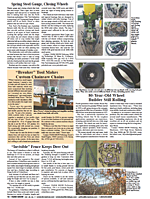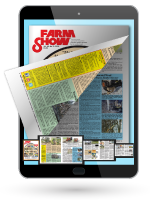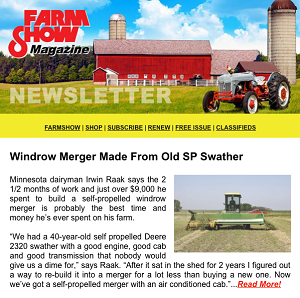You have reached your limit of 3 free stories. A story preview is shown instead.
To view more stories
To view more stories
SUBSCRIBE OR RENEW NOW
(If your subscription is current, click here to Login or Register.)2025 - Volume #49, Issue #5, Page #18
[ Sample Stories From This Issue | List of All Stories In This Issue]
Revolutionary Modular E-Dozer
Four years ago, Ahmed Shubber was working in his parents’ garage, converting an old gas-powered garden tractor into a fully electric model with a loader and remote control. That project earned him a $20,000 investment, which he used to convert a skid loader to all-electric. This past May, he unveiled the prototype for ..........
You must sign in, subscribe or renew to see the page.

You must sign in, subscribe or renew to see the flip-book
Revolutionary Modular E-Dozer
Four years ago, Ahmed Shubber was working in his parents’ garage, converting an old gas-powered garden tractor into a fully electric model with a loader and remote control. That project earned him a $20,000 investment, which he used to convert a skid loader to all-electric. This past May, he unveiled the prototype for a revolutionary Moonlander ML6, an all-electric, 750-hp, 32-ton bulldozer. A modular Gen 2 version is also in development.
In between, he went from broke with maxed-out credit cards to Lumina, a company projecting $44 million in excavation revenue in 2025.
To understand how he has progressed so quickly, watch the videos he has posted on YouTube and read his ongoing series of tweets on X, as well as his LinkedIn posts. Quotes in this story come from those and other public statements made by Shubber.
In an increasingly digital world, Shubber’s success can be measured in part by impressions. His first video had only 204 views after three years, and this writer was only his fifth subscriber. Compare that to him getting 500,000 impressions per week on X today.
Reaching his goals relies on the success of the Gen 2 ML6.
“A fleet of low-cost, second-generation Lumina dozers and power packs will enter service in early 2026,” said Shubber recently. “What looks like a dozer is actually a multipurpose platform designed to support 20+ configurations.”
Revolutionary in design and ready for remote or autonomous operation, it has roughly the footprint of a CAT D6. However, it has the bucket capacity, more power, and lower operating costs than a diesel D9. It’s estimated it’ll operate at half the price of a D9.
Equally revolutionary is Lumina, a company that has no plans to sell anything. Instead, Shubber will use a fleet of ML6s to perform work under contract, develop additional equipment based on its design, and leverage the technology being developed.
“Lumina’s master plan is simple,” stated Shubber in a tweet. “We’re building technologies to dominate four core markets: excavation, concrete, steel fabrication and lumber. We won’t sell our technologies. We’ll dominate one market segment and layer services on top of the next most adjacent segment.”
Shubber’s thinking goes far beyond the conventional box. Not only is the ML6 designed to compete with a D9 on the ground, but also on the road. It’s compact enough to be easily transported without needing to disassemble it.
The modular design of the Gen 2 ML6 is lending itself to the next Lumina product, BladeRunner. Slated for a 2027 introduction, BladeRunner is a 100-ton, 9-cu. yd. electric excavator that will use 60% of the components designed for the ML6. The cab, batteries, controls, thermal system, electrical architecture, operating software, autonomous sensor kits and more are all found on the ML6. The excavator is just the second step in the Lumina journey. RoadRunner, a front-end loader, is planned for 2029.
Perhaps most revolutionary of all is that Shubber has found ways to bring his products to market at a third to half the cost of competitive equipment. He has done so with the instincts of a FARM SHOW reader.
Lumina, as a company, does everything in-house. The first iteration of the ML6 was assembled in the U.K. for $3 million. Parts came from nearly 200 different suppliers. By January 2026, Shubber plans to have everything in-house. Modeled after Tesla, research, development and production will be vertically integrated. The production team even developed its own black paint.
“We design and build everything, down to our hydraulic tanks,” says Shubber. “Each one is a work of art, engineered in-house and zinc-coated to prevent contamination.”
Negotiating has also paid off. Lumina recently secured a multi-year battery module agreement that cuts the cost of the battery pack by nearly 68%. The pack is notable for its 10-hr. runtime and its ability to recharge to 100% in 75 min.
Whether or not Lumina achieves its goals, the company has been noticed by the competition.
“A director from a top three OEM met with us to ask for a licensing deal,” recounted Shubber. “They wanted to stamp their brand on our products. My response: We’re not your R&D department.”
Since the unveiling of the prototype, Shubber says he’s been inundated with interest from contractors, dealerships and more, eager to buy, sell or distribute. That included a major mining group that reached out in mid-June, asking Shubber to sell them dozers.
“We’ve got bigger things in mind,” was his response.
The company promises to launch an expanded website, which is currently only a single page. For more information at this point, follow @ahmedshubber25 on X or Ahmed Shubber on LinkedIn.
Contact: FARM SHOW Followup, Lumina Technology (www.luminatech.co).
To read the rest of this story, download this issue below or click here to register with your account number.



